NORTH WALES COAST RAILWAY:NOTICE
BOARD
Rheilffordd arfordir gogledd Cymru: Hysbysfwrdd
28 April 2014
 Last issue
Last issue Archive
Archive Share this issue
Tweet
Tweets by @NWrail1
Contributions and comments are encouraged: see the Contributions Page
This site is dedicated to all our regular contributors and supporters, and especially the rail staff of North Wales.
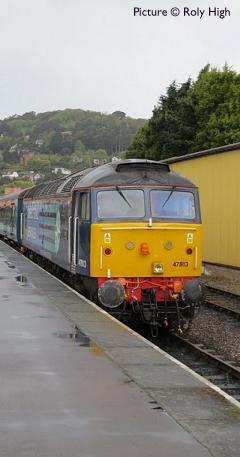
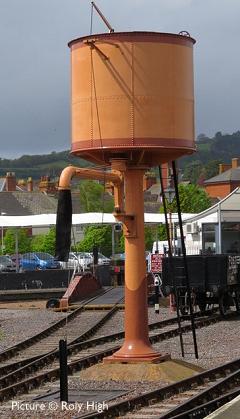
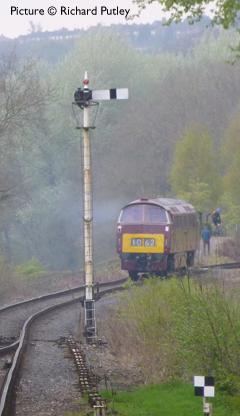
This list may be out of date if you are reading an archived page. For the current list visit our Calendar.
May 2014
Friday 2 May (change of date) Mid-Cheshire Rail Users' Association Excursion from Hooton, Chester and stations on the mid-Cheshire line to Dumfries, Kilmarnock and Ayr.
Monday 5 May Excursion Compass Tours 'The North Wales Scotsman'. Llandudno Junction, Colwyn Bay, Rhyl, Prestatyn, Flint, Chester, & Frodsham to Glasgow.
Thursday 8 May Llandudno and Conwy Valley Railway Society 'The Deganwy Dock Story' Eric Smith
Saturday 10 May Wirral O Gauge group open afternoon: 'We would like to invite model railway people to come along and bring a loco or just watch. We are also looking for new members to join us.' Unit 7 The Odyssey Centre, Corporation Road, Birkenhead, CH41 1HB on 10th May 2014 from 13.00 to 17.00. Admission £2. 2 rail F/s DC & DCC continuous tracks. More d etails can be obtained from Jenny Elliott on 0151 6530637 or j.elliott37[at]sky.com'
Tuesday 13 May 8E Railway Association Les Nixon - Railways of Scotland.
Tuesday 13 May (Change of Date) North Wales Railway Circle A.G.M. followed by Members Videos, Prints, Slides, and Digital work in the Photo Competition.
Thursday 15 May Locomotive Club of Great Britain AGM and Members/Visitors Slides & Digital Photos.
Saturday 24 May Steam on the Coast Vintage Trains Seaside Flyer hauled by steam loco 5043 Earl of Mount Edgcumbe from Tyseley, Wolverhampton, Stafford and Crewe to Llandudno for the Llandudno Air Tattoo which is taking place that day.
Tuesday 27 May Denbigh Film Club invites all railway enthusiasts to an evening of 'Railway Nostalgia - on Film' in aid of the Llangollen Railway Corwen Extension. Theatr Twm O'r Nant, Station Road, Denbigh. Doors open 7pm, show starts at 7.30. Licensed bar and refreshments available. Admission £5.
June 2014
Sunday 15 June Excursion Compass Tours 'The Cumbrian Moorlander'. Holyhead, Llanfairpwill, Bangor, Llandudno Junction, Colwyn Bay, Rhyl, Flint, Shotton, Chester, Helsby, Frodsham & Warrington Bank Quay to Carlisle via the Settle & Carlisle railway route.
July 2014
Saturday 5 July North Wales Area Group of the N Gauge Society. Welsh N Gauge Model Railway Show. St Mary's and St John's Halls, Rosehill Street, Conwy. What? - The largest gathering of N Gauge model railway layouts in Wales Opening times - 10.00am to 4.00pm Admission £4.00 adults - £3.00 concessions - Children under 15 Free when accompanied by a paying adult.
Sunday 27 July Steam on the Coast. Railway Touring Company. 'North Wales Coast Express' Liverpool, Broad Green, Warrington BQ, Frodsham and Chester to Llandudno, Bangor and Holyhead.
Tuesday 29 July Steam on the Coast. Railway Touring Company. Welsh Mountaineer. Preston, Warrington BQ, Frodsham and Chester to Blaenau Ffestiniog.
August 2014
Sunday 3 August Steam on the Coast. Railway Touring Company. North Wales Coast Express Crewe, Wilmslow, Stockport, Manchester Piccadilly, Altrincham and Chester to Llandudno, Bangor and Holyhead. Diesel-hauled Crewe - Manchester.
Sunday 10 August Steam on the Coast. Railway Touring Company. North Wales Coast Express Crewe, Wilmslow, Stockport, Manchester Piccadilly, Altrincham and Chester to Llandudno, Bangor and Holyhead. Diesel-hauled Crewe - Manchester.
Sunday 17 August Steam on the Coast. Railway Touring Company. 'North Wales Coast Express' Liverpool, Broad Green, Warrington BQ, Frodsham and Chester to Llandudno, Bangor and Holyhead.
Tuesday 19 August Steam on the Coast. Railway Touring Company. Welsh Mountaineer. Preston, Warrington BQ, Frodsham and Chester to Blaenau Ffestiniog.
September 2014
Tuesday 2 September Steam on the Coast. Railway Touring Company. Welsh Mountaineer. Preston, Warrington BQ, Frodsham and Chester to Blaenau Ffestiniog.
Sunday 7 September Steam on the Coast. Railway Touring Company. North Wales Coast Express Crewe, Wilmslow, Stockport, Manchester Piccadilly, Altrincham and Chester to Llandudno, Bangor and Holyhead. Diesel-hauled Crewe - Manchester.
Saturday 20 September Steam on the Coast. Steam Dreams: Cathedrals Express. London - Holyhead.
October 2014
Saturday - Monday 18-20 October Land Cruise Compass Tours Autumn Highlander. Holyhead, Llanfairpwll, Bangor, Llandudno Junction, Colwyn Bay, Rhyl, Flint, Chester, Delamere, Northwich, Knutsford, Altrincham, Stockport, Manchester Victoria, Bolton, Preston, & Carlisle to Inverness and Kyle of Lochalsh. A 3-day weekend break by rail to the Scottish Highlands, inclusive of two nights stay in quality hotel accommodation at Inverness. From £329.00 each.
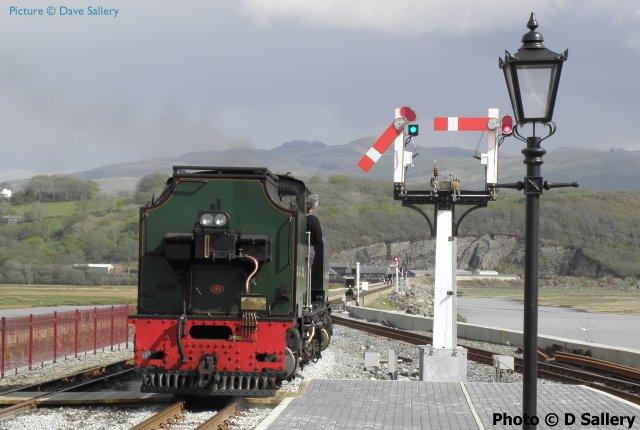
Welsh Highland Railway Garratt 143 is running around the train for the 16:00 departure from Porthmadog to Caernarfon on 24 April. The semaphore signals, like the rest of the new layout, are electrically worked. Picture by Dave Sallery.
Great Britain VII
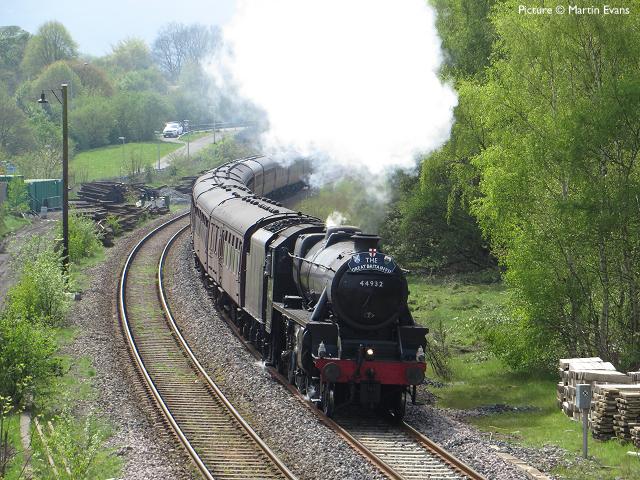
'Black 5' 44932 approaching Ruabon on 28 April with train 1Z71, the Bristol Temple Meads (dep. 08:16) to Grange-over-Sands leg of the 'Great Britain VII' railtour touting the UK behind steam over several days, 27 April to 4 May (price per person in Premier Class £2785 - First Class £1895). Picture by Martin Evans.
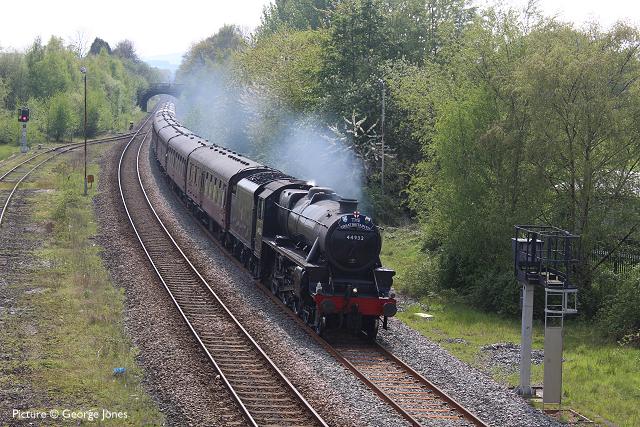
Running 71 mins late after losing time throughout the journey along the Marches line, and being held for longer than planned at Shrewsbury, 44932 passes the site of the former South Fork junction at Wrexham , as viewed from Ruthin Road bridge at 14:56 (George Jones).
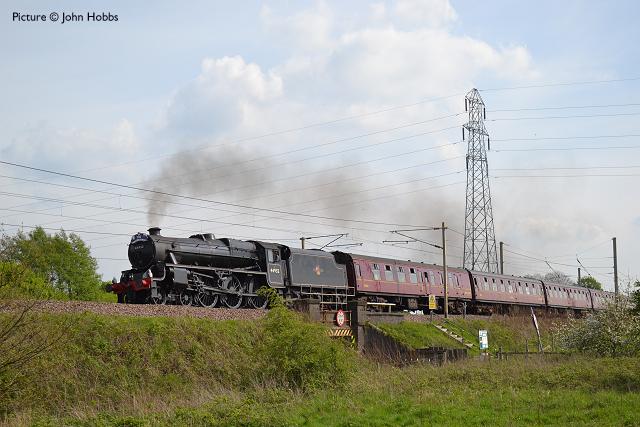
A little time had been recovered by the time the train passed Winwick Junction (John Hobbs). The Railway Touring Company's website had promised a Duchess of Sutherland on this working, but on the day it fell to one of the ubiquitous 'Black Fives' to tackle the 'climb to Llanvihangel summit.'
'Daisy' for Llangollen - by Evan Green-Hughes, Llangollen Railcars
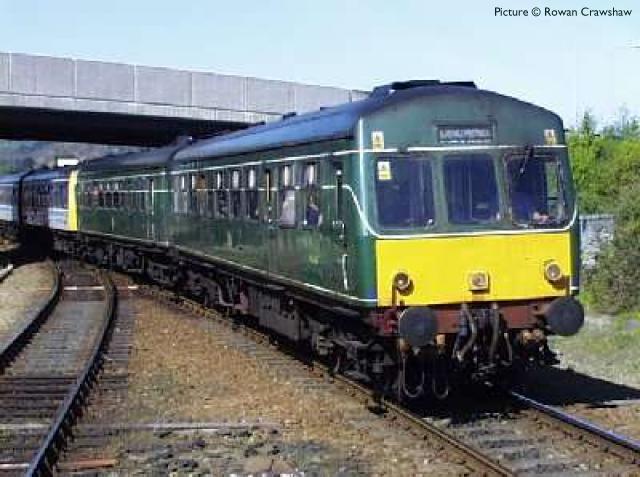
A Railcar which was once a famous celebrity in North Wales (pictrure above by Rowan Crawshaw) is to return for a gala at the Llangollen Railway over the weekend of 21/22 June. The two-car set, 101 685, known in its later days as 'Daisy' gained celebrity status in 1994 when it was repainted in historic British Railways green for services on the Llandudno to Blaenau Ffestiniog line. It remained in service - latterly in the Manchester area - until the last day of heritage Railcar operation in December 2003, following which it was bought for preservation, then spending brief periods at both the Elsecar and the Chasewater Railways before moving to the Midland Railway in 2009 for contract restoration.
Since then both vehicles have been extensively rebuilt but 'Daisy' has not yet seen public service. She will arrive in Llangollen in late May where she will be used for driver experiences and a photographic charter in the week before the gala, but she will see passenger service at Llangollen for the one weekend only.
The annual Llangollen Gala has established a reputation as being one of the foremost events of its type in previous years and features up to 16 departures each way per day with the units working in two, four and six car formations. This year trains will also travel as far as Bonwm on the new Corwen extension.
As well as 'Daisy' four of the home fleet of diesel Railcars will be in service each day and the lineís DMU Group will be exhibiting their partly-restored Class 105 trailer (made in Sheffield) and its Class 104 power car (made in Birmingham) at Llangollen station where visitors will see the extent of work required in the restoration of trains of this type. There will be sales stalls as well as the customary Saturday evening social function, which will this year take place at Glyndyfrdwy Station, with a special train operating to the site.
In response to requests Llangollen stationís buffet is to open specially early at 08:30 for breakfast on each day of the event and all the lineís intermediate stations will also be offering refreshment.
The Class 101 units were built by Metro-Cammell in Birmingham with production starting in 1955. They were at one time one of the most numerous of the first-generation Railcars and six of the type survived to the last day of operation in December 2003. The oldest of Daisyís coaches dates from 1956.
On the Somerset Coast Express - pictures by Roly High
(additional notes by Charlie Hulme)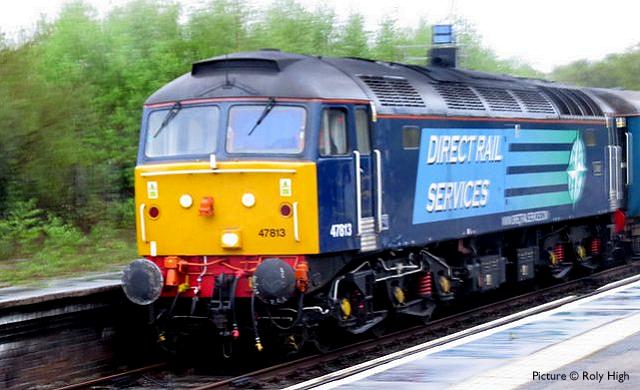
On 26 April (above) 47 813 Solent draws train 5Z91 the Riviera Trains empty stock working from Crewe holding sidings into Hooton's platform 1 to form the 'Somerset Coast Express' excursion to Minehead, organised by the Ffestiniog Railway Society Dee and Mersey Group , in collaboration with Chester Model Railway Club. 47 853 Rail Express was on the other end, and became the lead loco to haul the train as 1Z91 from Bristol, Taunton and then on to West Somerset Railway metals as far as their their terminus at Minehead.
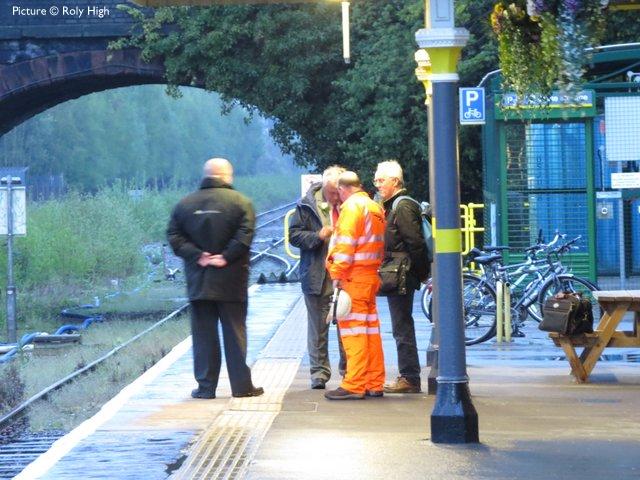
As usual, Network Rail and Merseyrail staff were in attendance at Hooton to supervise operational and safety issues.
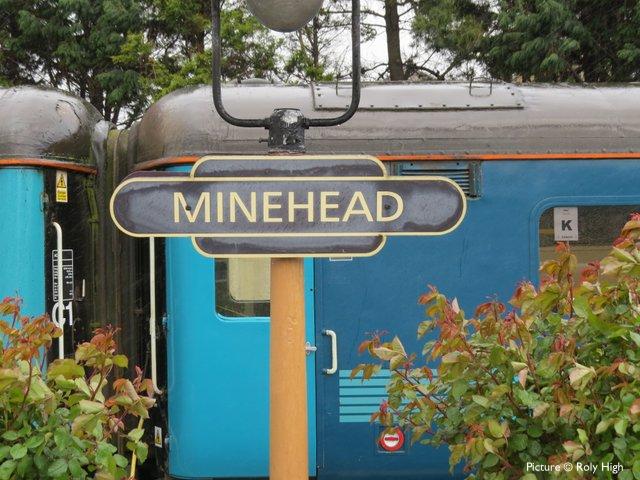
Seen on arrival at Minehead, the train included Mk 2 coaches formerly used in the Holyhead - Cardiff express, and still in de-branded Arriva / Welsh Government livery, purchased by Riviera when displaced by Mk 3 vehicles. Other coaches were ex-Virgin Trains stock of the same vintage still in Virgin red.
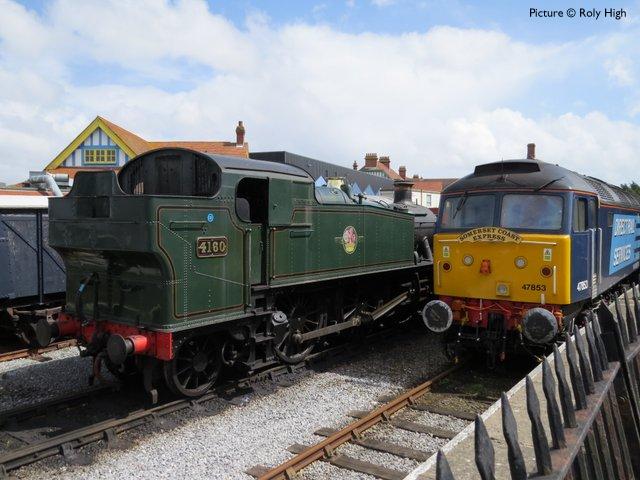
At Minehead, 47 853 and ex-Great Western 'Prairie Tank' 4160 which has (so far?) avoided the 'paint it black' craze.
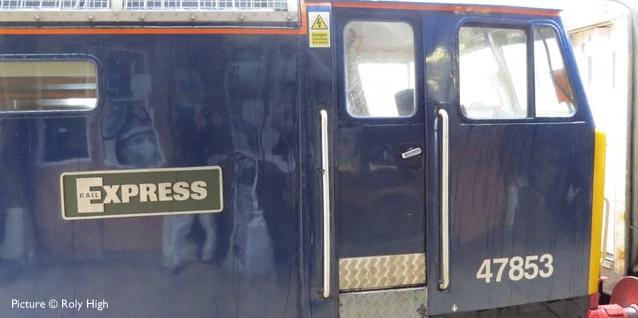
47 853 was one of several Class 47 locos named after railway magazines during their time with Virgin Trains. It is quite a historic machine, as in 1964, when numbered D1733 it was painted in an early form of BR blue as part of the 'XP64' train which toured the country showing coaches which had been modified to show new ideas in passenger comfort, and were the first to appear in the blue and grey livery which later become familiar to everyone. Virgin Trains re-created the livery, and the subsequent owner Riviera Trains retained it, but current owners DRS, whilst happily retaining the nameplates, have repainted in it their standard dark blue. Some of the XP64 coaches survived until the 21st century, but were reportedly found to contain blue asbestos, and may no longer exist today.
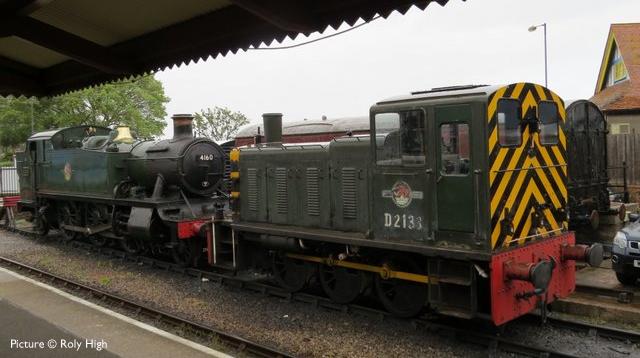
Class 03 shunter D2133. After withdrawal, this loco shunted at the British Cellophane factory in Bridgwater before passing into preservation.
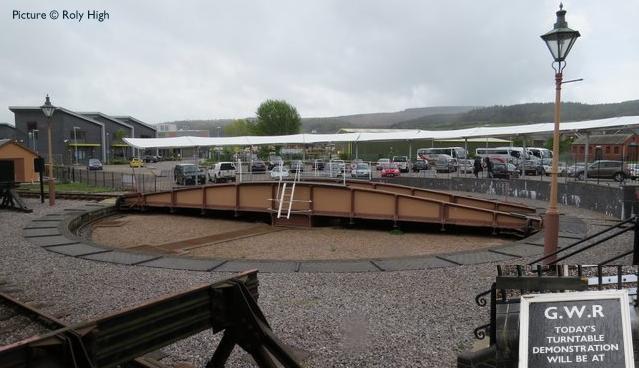
Minehead has a turntable, but there was to be no demonstration on this occasion. The turntable deck, originally just 55 feet long, was removed fom Pwllheli to Minehead by the preservationists in 1979, but was not brought into use, installed in a newly-built base, until 2008, extended to 65 feet to accept large locomotives.
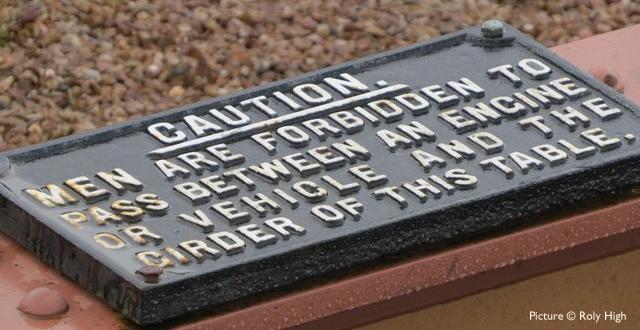
Some historic 'health and safety.'
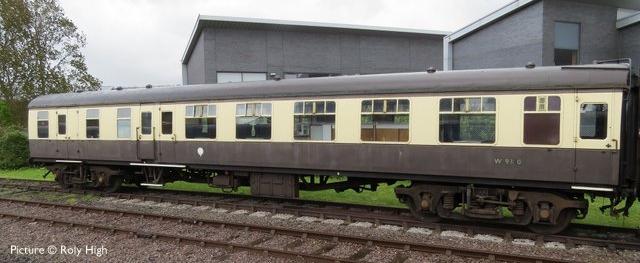
W9380 is a Mk1 BSO(T) - a Brake Standard Open converted with a so-called 'micro-buffet' location. This one has worked on the Llangollen Railway in the past; it was part of the 'Berwyn Belle' set before transfer to the West Somerset circa 2002.
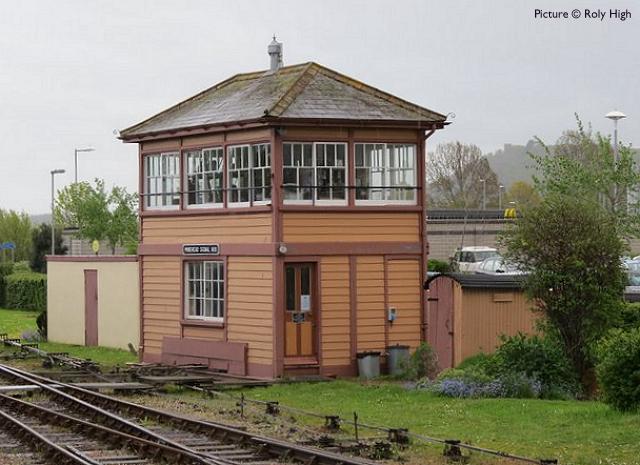
Minehead Signal Box: a classic Great Western example with its five-pane windows; the paint scheme ('light and dark stone') reflects Great Western Railway practice; according to the experts it was not until after for the formation of British Railways Western Region that the use of 'chocolate and cream' spread from carriages to buildings.
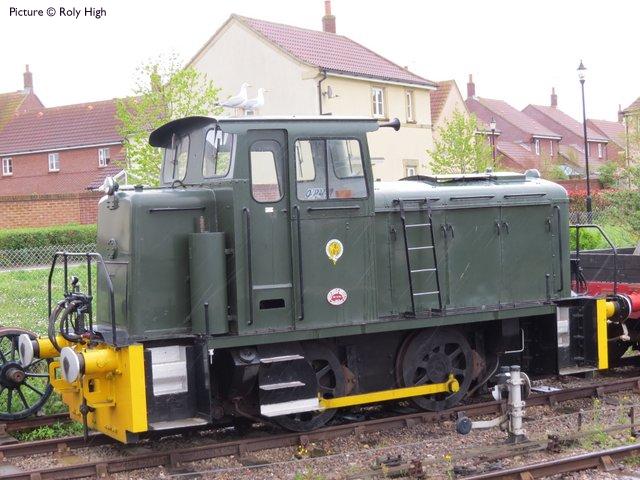
This Andrew Barclay 0-4-0 shunter is one of a pair that came from the Royal Ordnance Factory at Puriton in Somerset.
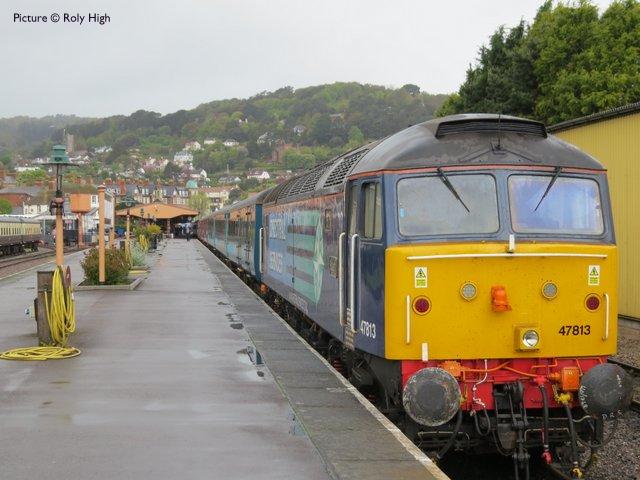
47 813 ready to haul the train on the return journey. Great credit is due to Network Rail, DRS, Riviera Trains,the team from Chester Model Railway Club/Ffestiniog Railway Dee
and Mersey Group,and, last but not least, The West Somerset Railway,for organizing a very good journey.
Quinn Glass saga
The Quinn glass-making plant at Elton, near to the Helsby - Hooton line, which opened in 2005, gained retrospective planning consent for the factory in November 2009 and a rail head for unloading materials was supposed to be operational within two years. Trainloads of sand from Norfolk began running in 2011, with road haulage from there to the plant, but the proposed facilities for direct delivery have yet to materialise. Currently the train runs (as required) from Middleton Towers to Warrington Arpley marshallling yard on Saturdays, arriving late in the evening. It 'lays over' at Arpley until late on Sunday night, proceeding to Ellesmere Port under cover of darkness, and returning to Warrington in the very early hours of Monday ... which explains how it has avoided our photographic contributors.
Comments made by the company's operations director in 2010 at an industrial tribunal (into the redundancy of some lorry drivers) are perhaps enlightening:
We made some proposals to Network
Rail because we are required to have a railhead on site. It was broadly
agreed to be acceptable to them. We started work and on the right-hand
side of the site, we spent tens of thousands of pounds clearing the
site and getting it ready. We moved badger setts, we did all sorts of
things to get the plant ready. Subsequently Network Rail came back to
us and said we want you to spend an awful lot more money on upgrading
Helsby and the sidings at Growhow [fertilizer plant, formerly Kemira]
at your cost ... It's been frustrated and more and more frustrated as
time goes by. We had to write to the council saying we would not
achieve our planning consent requirements right now because of the
issues, so itís not for want of trying.
In early April the issue appeared in the Chester Chronicle again in a rather garbled report of a Cheshire West and Chester planning meeting. A 'refined' plan for the rail link is now on offer, the rail head to be '50 metres' away from the originally planned site. The plans - this link goes to the Council planning database - were recommended for approval, so maybe something will happen.
The View at Crewe - pictures by Peter Dickinson
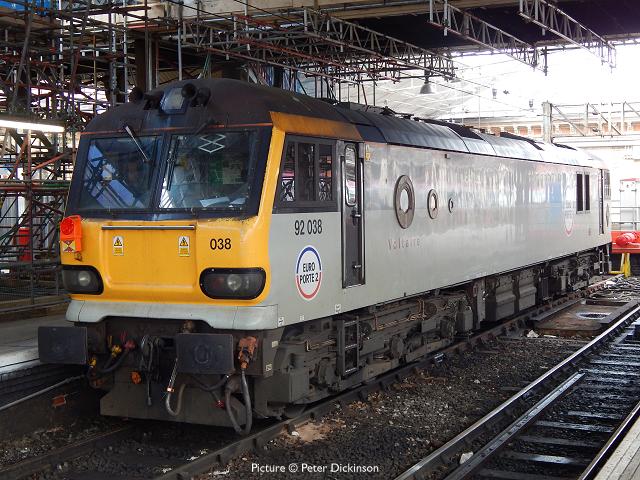
Stabled in a bay platform at Crewe station on Sunday 27 April, 92 038 Voltaire. This was one of the nine Class 92s which, when built, were owned by French National Railways (SNCF). Today it is part of the fleet of GB Railfreight (GBRf) although it carries the loco of sister company 'Europorte 2' (which has in fact been renamed Europorte Channel) - both companies are subsidiaries of Eurotunnel, operators of the Channel Tunnel. The Class 92 locos were built to run through the Channel Tunnel, and are the only ones authorised to do so, but the GBRf machines are mostly used within England. Since 2013, they can be found (although not always) on the 14:16 Manchester Trafford Park - Felixstowe container train which runs via the West Coast Main Line the North London line and the Great Eastern route.
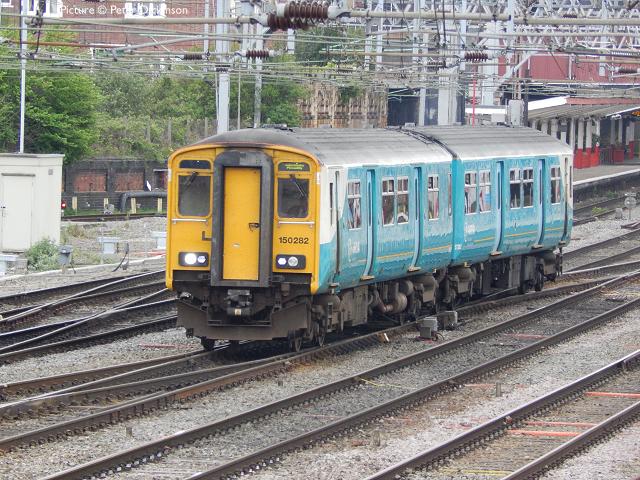
The preserved signalbox at Crewe North Junction, now part of the Crewe Heritage Centre, makes a useful viewpoint for train-watching. Above, substituting for the more usual Class 175, 150 282 makes its way across from Platform 6 to the Manchester line with a train from South Wales.
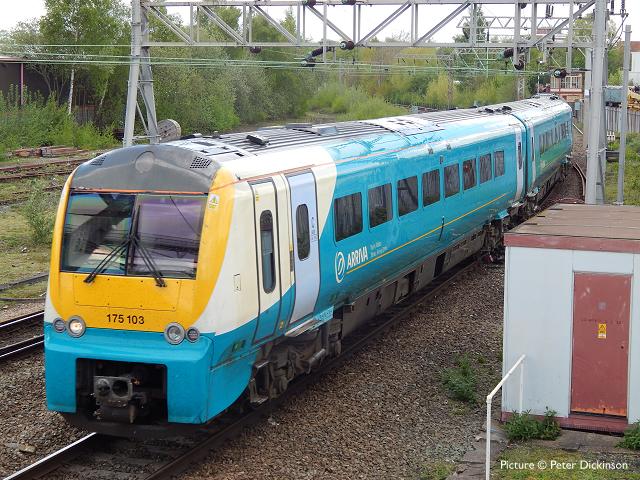
175 103 approaches the station round the curve from the North Wales line.
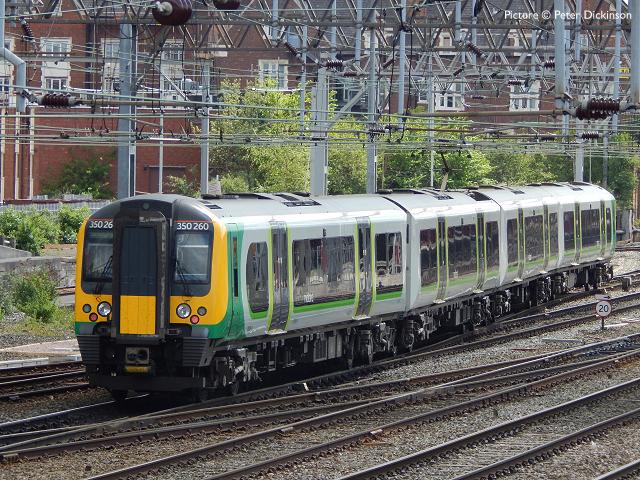
The Crewe Arms Hotel, built in 1838 to serve the station which at the time was in open countryside, forms a backdrop to London Midland 'Desiro' 350 260. These 350/2 versions have 3 + 2 seating and were intended for the London commuter routes, but unfortunately also appear on long-distance services.
Past Times with John Hobbs - Gwersyllt: Panniers on the GC
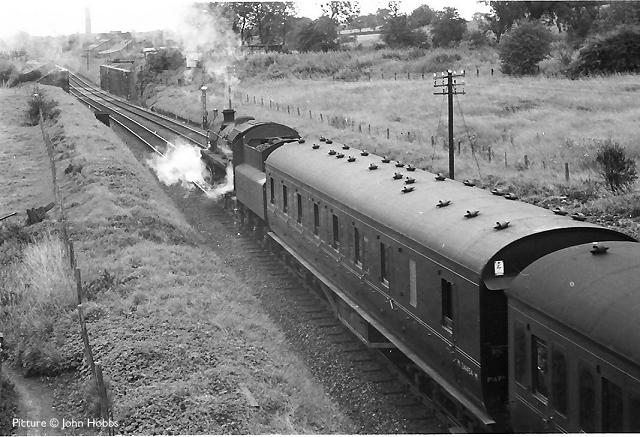
BR Class 4 4-6-0 75012 leaves Gwersyllt (above) on 30 August 1965 with an August Bank Holiday Monday train for Wrexham (Central). This was, in the parlance of the "Special Traffic Notice W2" - 2J79 11.16am from New Brighton to Chester (Northgate) - madesteam diverted and re-timed and be load 6 non-corridors - 196 tons. It must have 'topped and tailed' into New Brighton on the empty coaches prior to this working.
The line beyond the loco is lowered between the bridge abutments, where the line from Wheatsheaf Junction to Minera crossed the path of the WM&CQR; formerly this line reached Brymbo and Minera via two very steep inclined planes, which were part of the North Wales Mineral Railway which ran from the wharfs at Saltney, latterly this was a branch to Gwersyllt Colliery; the remainder on to Brymbo having closed between 1862 and 1908, the line from Croes Newydd joined the Wheatsheaf Junction line just east of Brymbo station. The first coach is a Push & Pull driving coach which has been pressed into use as a passenger brake van.
On the LNER outpost in Wales, C14 & N5's, Ivatt 2-6-2T's and BR Standard. Class 3 2-6-2T's from Wrexham (Rhosddu) shed once powered the passenger trains between Wrexham and Seacombe; from 4 January 1960 a new modern diesel service was introduced, this was diverted to serve New Brighton instead of Seacombe which was closed. That was the end of steam, or so we thought, but it became the practice to run steam hauled passenger trains on Bank Holiday Mondays between Wrexham and the new destination of New Brighton because the capacity of 2/4 car DMUs was limited.
LMS 2-6-4T were apparently used on these trains in the early years, later BR. Class 4 2-6-4T's were used. However these were transferred away by 1965 and Croes Newydd resorted to using Pannier Tanks, as the run round loop at New Brighton was too short for anything longer than a 2-6-4T unless a second locomotive was provided to provide a shunt release. Inevitably some one did send a Standard Class 4 4-6-0 to New Brighton, at the head of a train. This created chaos at New Brighton on Easter Monday 1966 and throughout the electric Mersey railway network as its train had to be propelled to Bidston to enable the locomotive to be released and run round the stock.
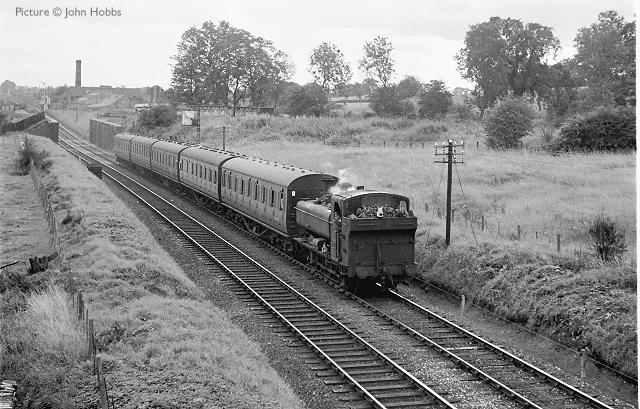
Croes Newydd sent out another Pannier in the afternoon to prevent chaos occurring. Unbeknown to us of course these were probably the last scheduled passenger trains to be worked by Pannier Tanks anywhere on the national network; it was truly an Indian Summer of steam on these ex LNER lines; the use of former ex GWR locomotives on former LNER lines was itself a rare event except perhaps for some turns out of Neasden shed where 51XX 2-6-2T's tanks were used to work out of Marylebone, on the GCR extension for a while.
Above, 4683 arrives at Gwersyllt with the 13.04 Wrexham Central to New Brighton; the same rail over bridge can be seen in the background as in the previous view but beyond that can be seen Brymbo North Junction, on the northern side of the triangle which formed the Junction with the line to Brymbo (WMCQR) and latterly the access to Gatewen Colliery before this was altered to be from Moss Valley Junction via Croes Newydd. A nice rake of LMSR non-corridor stock forms the train, these vehicles too would be shortly swept away in the face of modernisation.
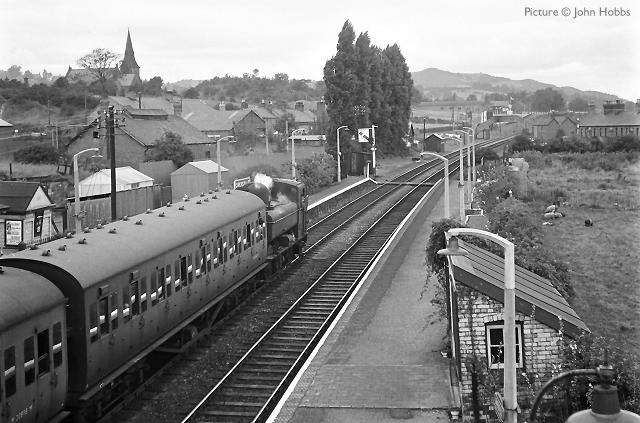
4683 Is seen again this time looking towards Shotton, as it pulls into Gwersyllt station.
The mistake has been made several times, in the railway press lately, of referring to Cheshire Lines Committee (CLC) lines beyond Chester; however the CLC ended at Chester (Northgate); the LNER were the successor of the Wrexham, Mold & Connahs Quay Railway and the Manchester , Sheffield & Lincolnshire Railway (MSLR) which owned the line from Chester (Northgate) to Hawarden Bridge Junction and the North Wales and Liverpool Railway (NW&LR) which owned the line from Hawarden Bridge West Junction to Bidston. The line on to Seacombe was owned by the Wirral Railway. The MSLR became the Great Central Railway and this took over the NW&LR and the WM&CQR in 1904. For more detail the see the book Wrexham Mold & Connahs Quay Railway by J.I.C Boyd.
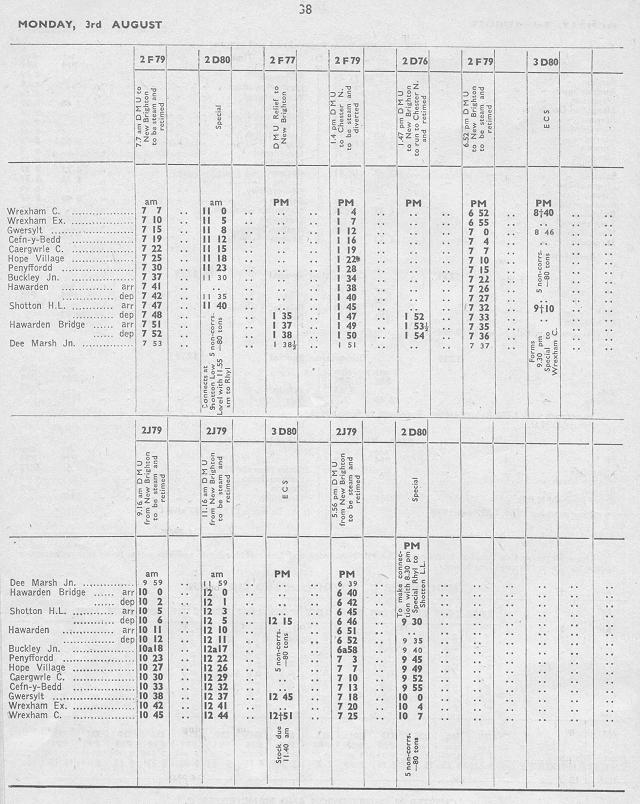
An extract from the Special Traffic Notice W2 for Saturday 1st August to Friday 7th August 1964; for Monday 3rd August for the line from Wrexham Central to Dee Marsh Junction. It features the changes to the timetable on a similar Bank Holiday to that featured in the photographs; however arrangements were different in the one featured here. One part which is especially interesting shows workings from Wrexham (Central) to Shotton (High Level) in connection with other workings from Shotton (low Level) to Rhyl and return. Just imagine a whole train load of passengers detraining and wandering off between the platforms at Shotton - also, 5 non-corridors would weigh more than 80 tons! More like 150 tons.
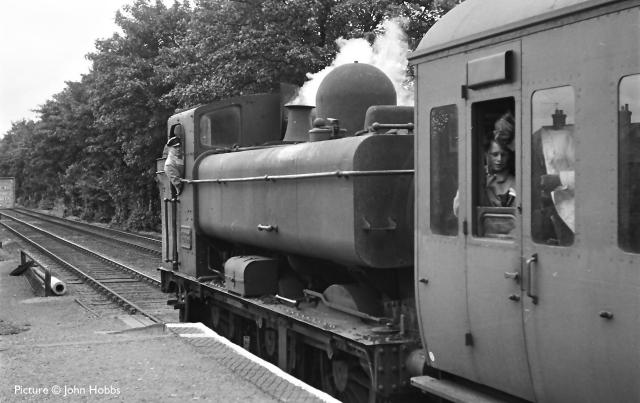
4683 stands at Cefn-y-Bedd with the 13.04 Wrexham (Central) to New Brighton, again on 30 August 1965.
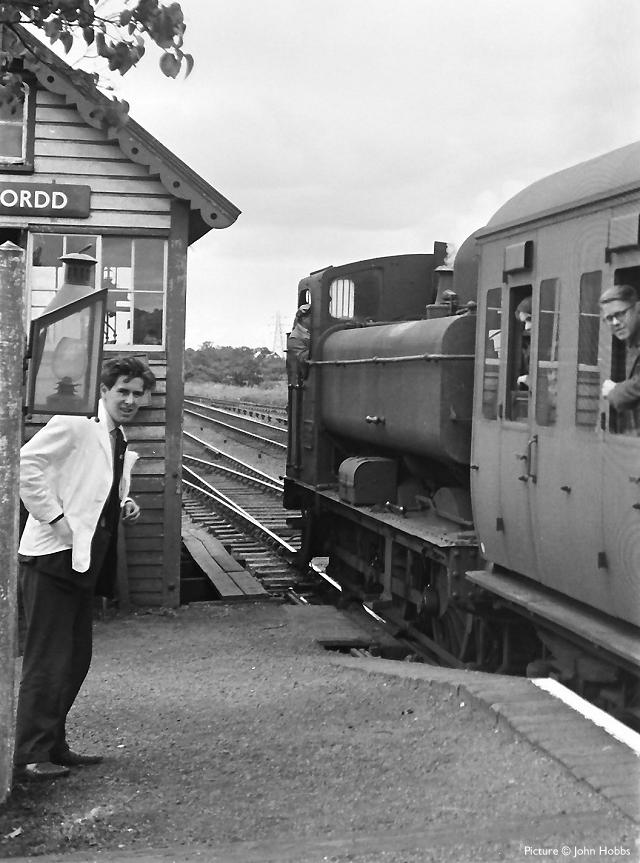
4683 has progressed further to Penyffordd, by the old signal box which was later replaced by a more modern BR Standard structure, while Chris Magner, a.k.a. 'Trolleyman' makes a valiant effort to sell tea to the passengers / enthusiasts on the non-corridor train. Oil lamps still illuminate the platform at this ex-LNER backwater.
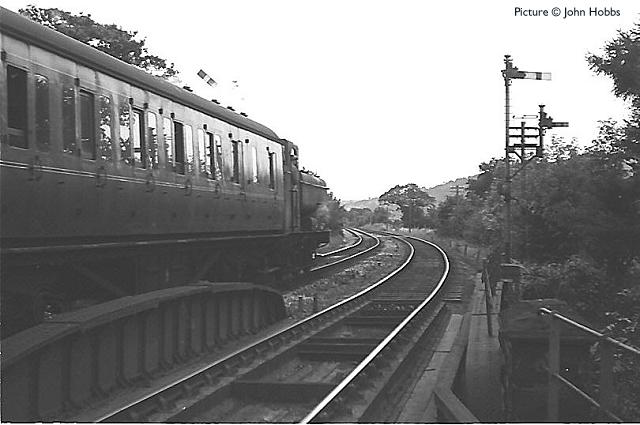
Earlier in the day 4683 leaves Penyffordd for Wrexham with the 09.16 New Brighton to Wrexham (Central). The train is crossing the bridge over the A5104 Chester to Corwen Road. The Home signal to the right has short additional arm for the spur down to the former Chester to Mold/Denbigh line where traffic from Rhydymwyn / Hendre Quarry, Mold and Padeswood was sorted.
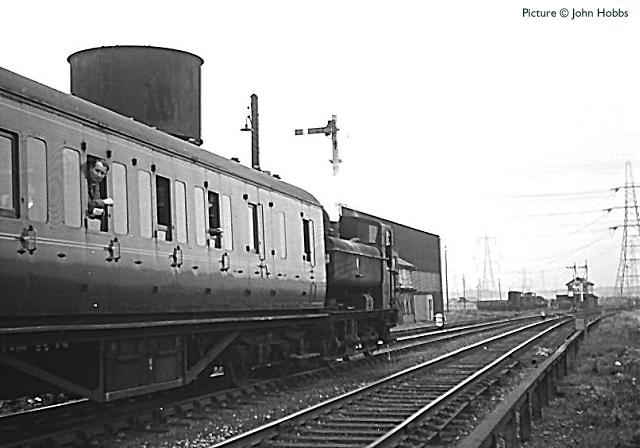
Another pannier, 9630, leaves Hawarden Bridge, the station provided for workers at Shotton Steelworks, with the 18.52 Wrexham (Central) to New Brighton, having replaced the BR Standard Class 4 4-6-0 75012 which had worked an earlier part of the diagram; that loco could not work into New Brighton and run around the stock because the head shunt was too short for it; Croes Newydd Depot therefore replaced it with another Pannier as seen here.
This turn was probably the last to use an ex GWR 0-6-0PT on regular passenger trains, albeit as a replacement for DMUs on a Bank Holiday but the ex GCR/LNER was an interesting place for such an historic occurrence and something which went relatively un-noticed by railway enthusiasts at large.
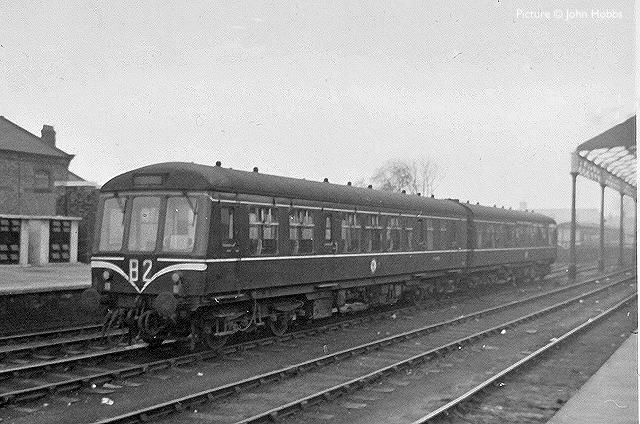
A 'power-twin' Diesel Multiple Unit, the furthest of the pair being M51562, which was the '1000th DMU vehicle built at Derby Works' and had roof boards proclaiming it, stands in Chester Northgate Station, circa 1961. This vehicle is preserved by the National Railway Museum and is currently based on the East Lancashire Railway, although its future lies elsewhere.
There were twelve of these power-twin units provided to cope with the steep gradients from Shotton (High level) to Buckley Junction and they originally exclusively worked the Wrexham (Central) to New Brighton and Chester (Northgate) services. M51561 - M51572, were Motor Compositeswere coupled to M50924 - M50935 which were Motor Brake seconds. Thery werr later split up and worked with other similar vehicles.
Picture News
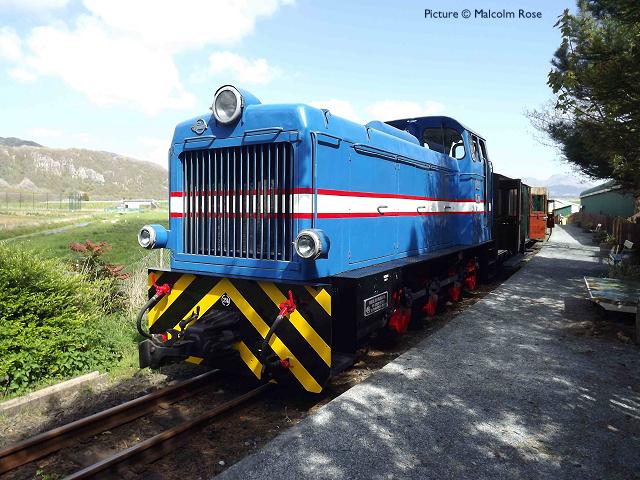
18 April was 'Polish Diesel Day' on the Welsh Highland Heritage Railway at Porthmadog. Malcolm Rose's picture shows ex-PKP (Polish State Railway) LyD2 class loco Eryri, built in Romania in 1977, waiting at Heritage centre / Gelert's Farm station to return to Porthmadog Station.
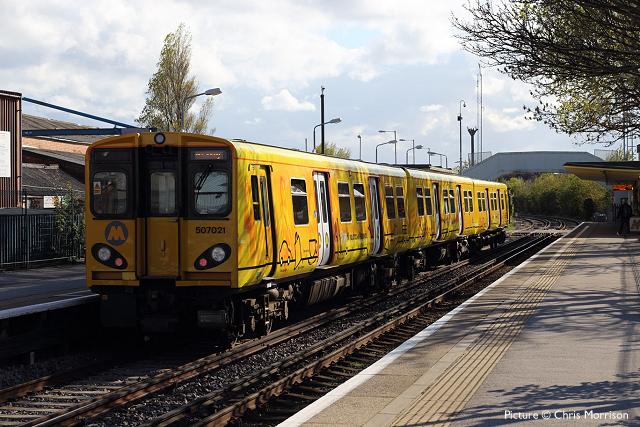
The new-liveried Merseyrail units have grey vinyls on one side and yellow on the other. 507 021 displays the yellow at Hoylake heading for West Kirby on 26 April (above) ...
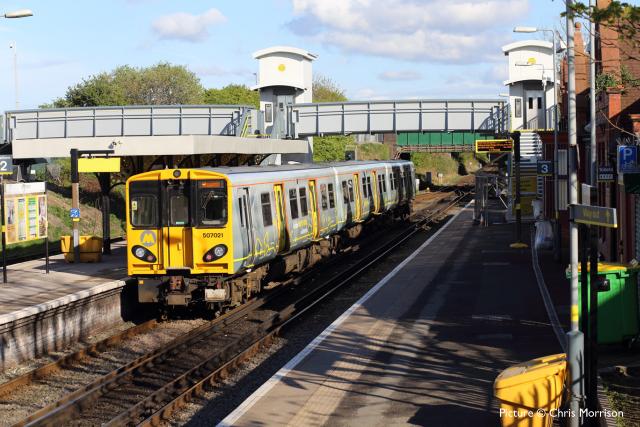
... and grey at Birkenhead North on the way to Liverpool Central a little while later. The new footbridge with lifts is in situ but not yet commissioned. Pictures by Chris Morrison.
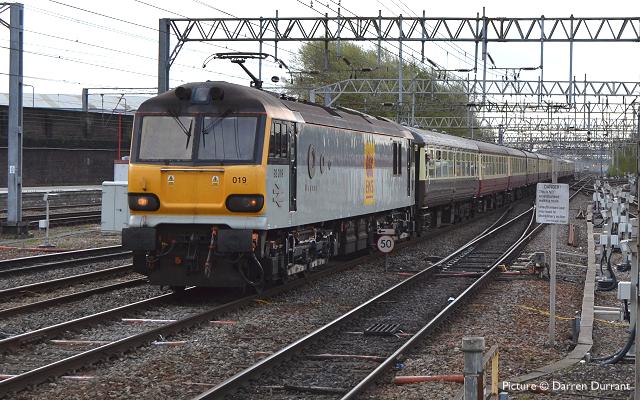
DB Schenker electric loco 92 019 Wagner heads the UK Railtours' 'Lancashire Hills and Coast' excursion through Crewe station on 17 April (Darren Durrant).
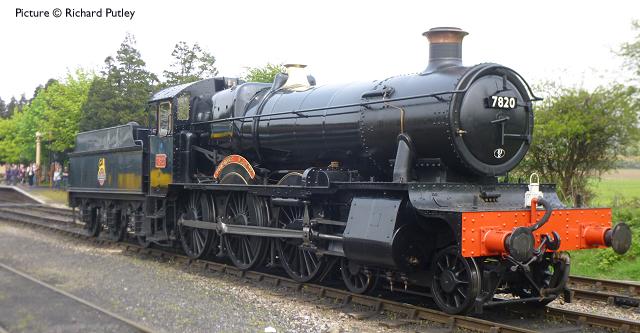
Richard Putley sends us another example of the trend towards '1950s black' on preserved locomotives: 7820 Dinmore Manor seen at Toddington on the Gloucester Warwickshire Railway on 21 April, without the benefit of the London and North Western-style lining out which was specifiied for mixed-traffic locos in the 1950s. Of course the owners Dinmore Manor Locomotive Ltd have done a fine job in restoring this loco from scrap condition, and can paint it any way they like, and of course, it was built in 1950 under British Railways so never was a Great Western loco, but green surely does look so much better?
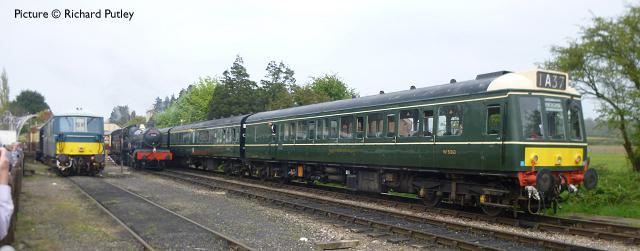
Also at Toddington on the same day were elecro-diesel E6036 and the railway's Class 117 DMU (Richard Putley).
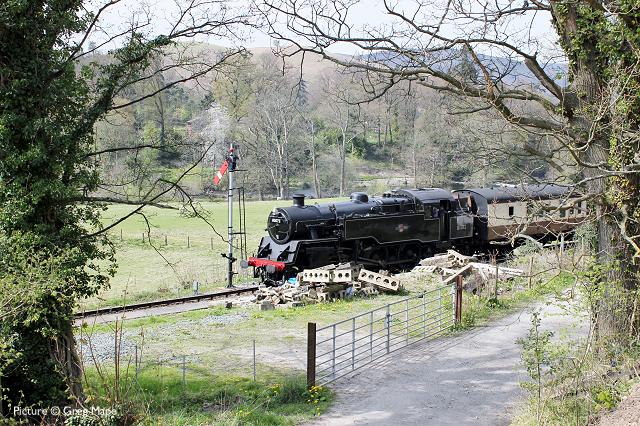
Greg Mape writes: 'While on a walk along the canal at Llangollen on 16 April was lucky enough to get this shot of 2-6-4T 80072.'
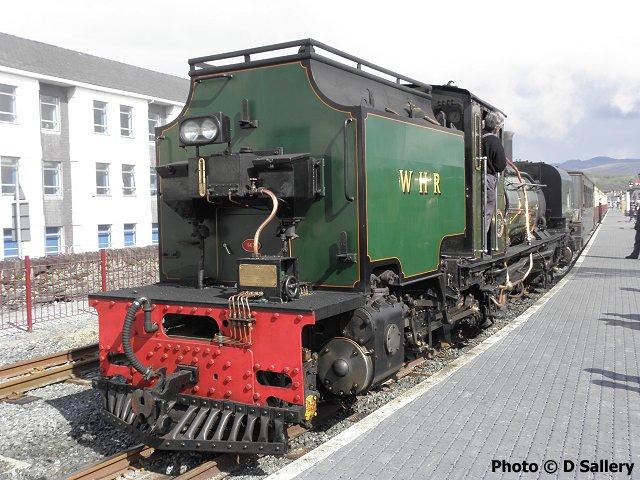
Porthmadog on 24 April, with loco 143 on the 16:00 to Caernarfon (Dave Sallery). These Beyer-Garratt locos, built in Manchester for a line in South Africa, certainly are impressive picces of machinery.
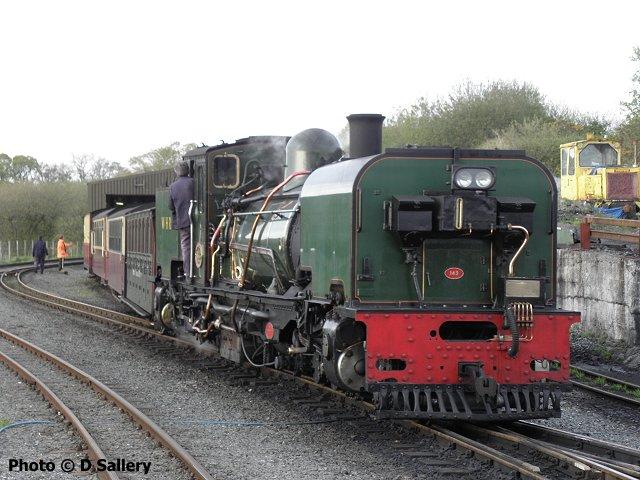
Later in the day 143 is seen in Dinas backing the stock into the carriage shed (Dave Sallery).
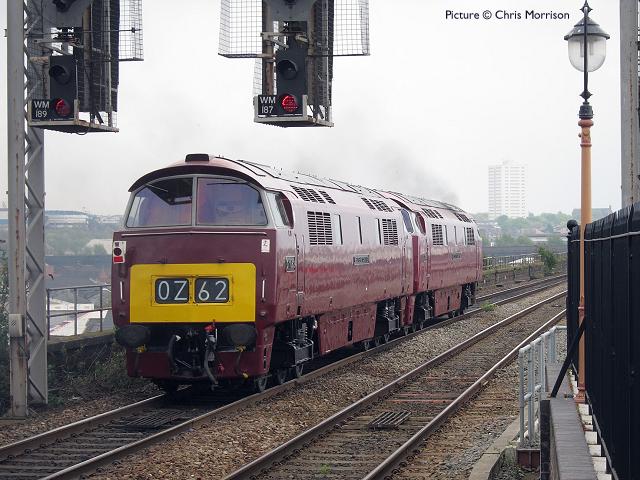
D1015 Western Champion hauled D1062 Western Courier from the Severn Valley Railway at Kidderminster to Tyseley for tyre turning as 0Z62 on 22 April. The two maroon class 52s are seen passing Birmingham Moor St. D1015 returned D1062 to the SVR on 25 April (Chris Morrison).
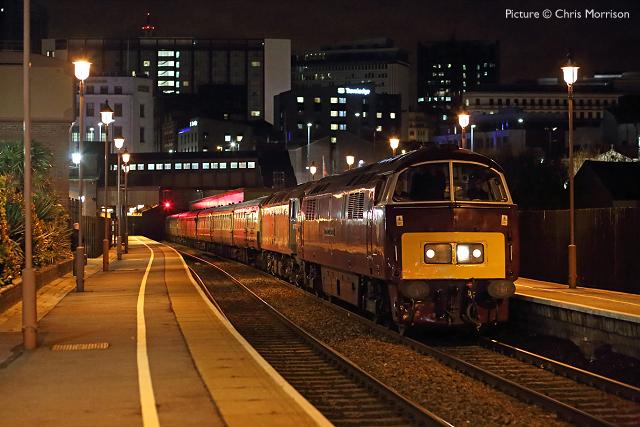
On 26 April D1015 worked the Tyseley - Kingswear 'Devonian' excursion as far as Paignton. The return working is seen passing Birmingham Moor Street with 47773 coupled inside to provide carriage heating (Chris Morrison).
The Snowdonian
'The Snowdonian' on 12 April was a through train from Caerarfon to Blaenau Ffestiniog over the narrow-gauge network. This YouTube video, created by Charlie Hulme from pictures by Jack Bowley, shows the special, and other trains seen on the day.
North Wales Coast home page | Archive | Previous Notice Board